Milk is selling at about half the price. From Kashmir to Kanyakumari … all are suffering
The nationwide lockdown has broken the back of the milk producing farmers. The price of one litre of milk has plunged to Rs 15-16 per litre, less than the bottled water selling in the market
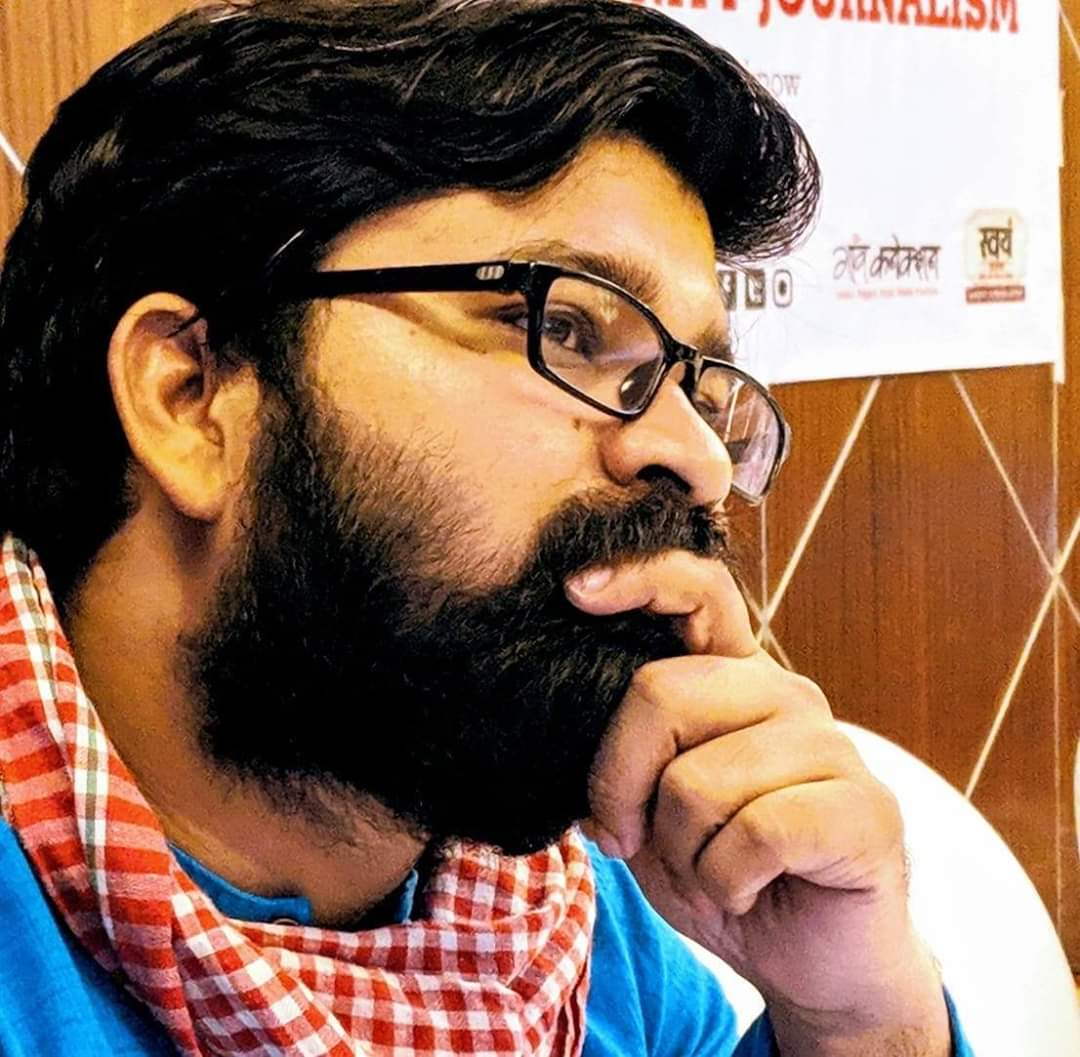

The nationwide lockdown in India, to prevent the spread of coronavirus, has broken the back of the milk producing farmers. The condition is such that the price of one litre of milk has plunged to Rs 15-16 per litre. The price of bottled water in the market is higher than this. Gaon Connection spoke to the milk producing farmers of 14 states of the country. From Jammu and Kashmir to Kanyakumari, all are suffering.
The attempts of Deepak Sharma, a farmer from Sujatpur village in Sambal district in Uttar Pradesh, to further develop his dairy work with farming, have received a severe blow due to the lockdown. He said: “The cow’s milk use to sell at Rs 30 to 32 per litre before the lockdown. A couple of days into the lockdown, the price came down steeply. Now, milk is hardly selling at Rs 15-16 per litre.”
The lockdown has led to a triple impact on the milk producing farmers of the country. One, they are not getting the right price for milk, the other, their cost is increasing and finally, nobody is even buying the milk that is being produced.

Sandeep Sonen, a farmer from Tapwan in Nashik, Maharashtra, has 60 desi cows. Before the lockdown, he would personally deliver milk to the cities, but now he is forced to give away his 50 litres of milk daily at unfairly low rates.
He informed Gaon Connection over the phone: “I produce A-2 milk. I used to supply my milk directly to colonies and houses, but was not allowed in those places since the lockdown had happened. The milk, which earlier sold at Rs 85-95 per litre is now selling at Rs 25-30, and is not even selling completely. I have to dole out at least 50 litres of milk free per day. My income has come to an absolute halt, but the expenditure will, nonetheless, continue.”
Sandeep is also worried about the rising price of fodder. He said: “A bundle of Rs 250 is now costing Rs 500. Earlier, the rate of 50 kg grains was Rs 1,500-1,800, now it is Rs 3,000. Bran, chooni, khali have become costlier by 30 to 40 per cent. One, there is no one buying the milk, no income is happening and on top of that, the expenditure is continuing to increase.”
The worst loss due to lockdown is happening to small milk producing farmers. The big milk producers are giving their milk to the milk cooperatives, in the society, the vehicals come to their doorsteps, but the farmers who used to supply milk to hotels, tea shops and houses are incurring more losses.
Vijay Kumar Patil, a 28-year-old dairy farmer from Kanhapur Taluk, village Gundyanti in Belgaum district of Karnataka, has 10 cows that produce around 100 litres of milk per day. His father cultivates land. To increase household income, he started the dairy work, after finishing his studies in the year 2018. Everything was going well, but the lockdown has halved their earnings.
Vijay informed: “Three of us together supplied 100 litres of milk to the houses. The price of one litre of milk was Rs 45-50, but now the police do not allow us to go anywhere. So, we are now leaving milk at the government milk company which is giving us Rs 30 a litre. Now, if we consider the rate before the lockdown, we can see that there is a daily loss.”
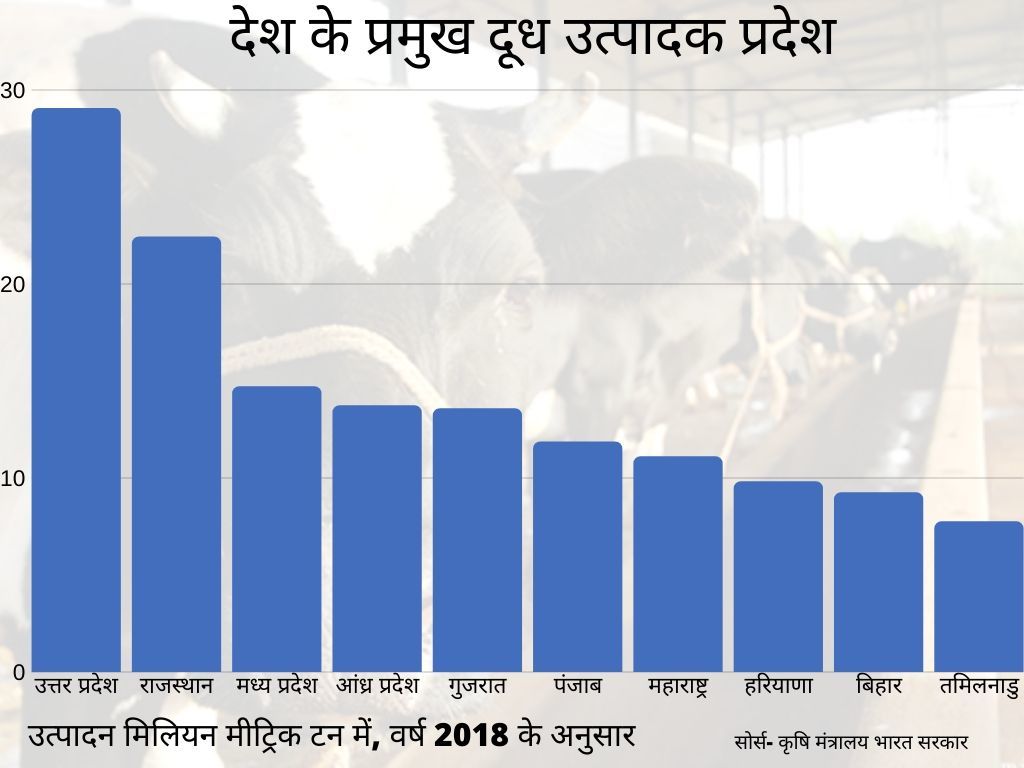
The agriculture ministry report says that about 75% of India’s milk production is by small, marginal and landless farmers. There are about 10 crore dairy farmers, that is, about 50 crore people are dependent on income from milk production. This is not a small number of people.
Shivam, who lives in Pallu in Hanumangarh district of Rajasthan, first had sold milk to the society, but did not get good price for milk there. In the year 2019, he opened a dairy shop and started selling milk, but is now regretting it.
He explained to Gaon Connection over the phone: “I had started this work thinking that it would boost my profit. I had even begun making some gains, but now everything is ruined. I am selling cow milk for Rs 17 and buffalo milk for Rs 20. I produce 50-60 litres of milk daily. In the village, everyone has milch animals so no one would buy any milk here. Aroud 25 litres of milk is left over daily. Some of this goes to feeding the calves and some I give free to the people. Initially I had thought of making ghee from the milk, but then for how many days would someone do it?”
A couple of days into the lockdown, there were reports from several states that farmers were throwing milk on the streets. Then the farmers had said that if they are not able to sell milk, what would they do keeping it with them. Now that the lockdown has been extended, the concerns of milk farmers have increased.
The milk producing farmers of Guwahati in Assam are concerned about their cattle more than the prices of milk. Shivam Pal, 40, living near Nandbari Railway Officer Colony, said: “I carry about 120 litres of cow’s milk every day. Hotels and shops are all closed. I hope daily my milk to be sold somehow. The Rs 40-42 milk is selling at Rs 18-20 per litre, but I am most worried as to how to keep my animals alive. I have 80 jersey cows. I am now left with fodder to last only two to three days more. We are constantly requesting the government to arrange us some fodder. Because of the lockdown, we are not able to go to the village to get the same.”
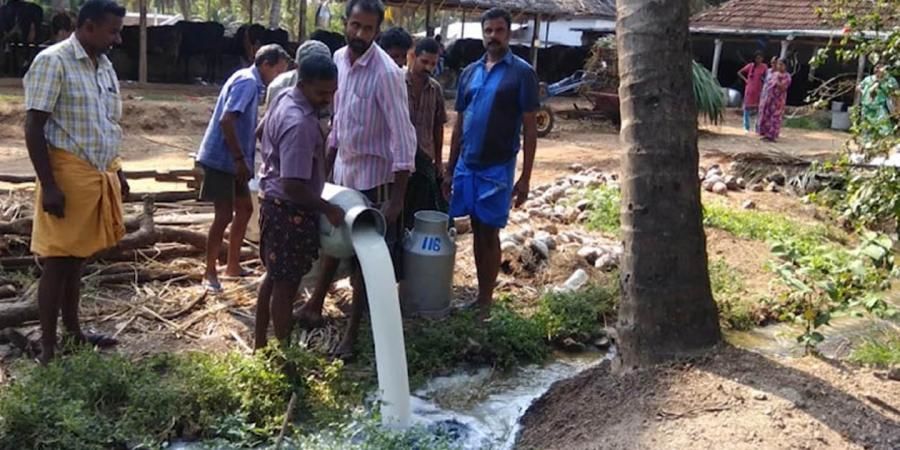
He added: “We too are selling milk, but our cattle have to be saved first. The fodder which was for Rs 1,000 per sack (50 kg) before the lockdown has now gone up to Rs 1,500. We have also been making cream from milk but again where will we store it.”
It is not that milk prices have been reduced only in the local markets. Big dairy traders have also reduced milk prices. Amarjit Singh of Meghwal, district Hoshiarpur, Punjab, supplies about 500 litres of milk to Nestle Company at Moga, but recently the company is constantly reducing the price of milk.
He told Gaon Connection over the phone: “The price of cow’s milk was earlier Rs 38 per litre. Talking about today (April 16), the company bought from me 4.7% fat milk for Rs 34.11 a litre. Since the lockdown, the price has gone down by more than Rs 4. The local price in the villages is even lower. So, it is better to continue selling them at a little loss. The price of green fodder is also rising here.”
MS Tarar, a dairy farmer from Shamli district in Uttar Pradesh, is also making the same allegation. He said: “All the cooperatives, except AMUL, have slashed the procurement prices of milk. Parag is under the government of Uttar Pradesh, but it has lowered the price of cow’s milk from Rs 43 to Rs 32. There are some local companies, they are taking milk for Rs 20-22. In many places, milk and ghee is being given to the villagers. I am supplying some milk to the villages, and making ghee from the remaining milk.”
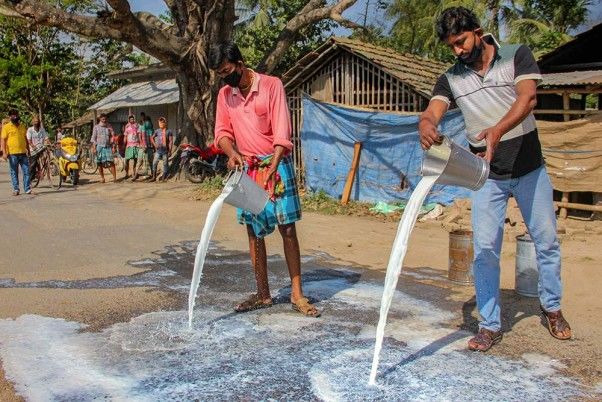
The farmers who sell milk to small dairies are suffering more, but the dairy operators also have their own arguments.
Harshit Goyal, owner of Gupta Dairy, who is living in Khera, in Karnal district of Haryana, said: “I myself sold cow’s milk at Rs 45 and buffalo’s at Rs 60 a litre and am now selling cow’s milk at Rs 25 and buffalo’s at Rs 30. I used to supply 50-60 litres of milk daily to various hotels, all of which are closed. The milk was also sent upon bicycles to colonies and tea shops, even that is not happening presently. I find myself with about 250 litres of milk daily to be disposed. With reat difficulty, I manage to sell just half of it. Where from will I give more money to the dairy farmers?”
He added: “I am making ghee from the remaining milk, but the small farmers who need money every day do not even have this opportunity, they simply need to earn money every day. I am helping them by even buying cow’s milk at Rs 20/litre. At least, they are getting some money every day.”
The cost of milk production has also risen due to lockdown. The movement of veicles has been stopped due to lockdown. This is why fodder is not reaching from one district to another.
Alok Kumar, a dairy farmer living near Kaathal Mor in Ranchi, the capital of Jharkhand said: “The price of milk has gone down to Rs 20-30, and the price of fodder is also increasing arbitrarily. The sack of 50 kg bran was Rs 900 before the lockdown and now is at Rs 1,500. The price of husk has gone up to Rs 1,300 from Rs 700. We are meeting the needs of people. The government should have made it cheaper at such a time. We are suffering on both sides.”
He added: “All my cattle are kept in Khoonti. I used to haul milk from there to sell here daily earning decent profit. The milk of Rs 40 is selling there as low as Rs 20-21.”
Soubhik Kundu, who lives in Golapur, Nadiya district, West Bengal, is also worried about the rising price of fodder. He said: “I have no problem with the price of milk because I supply about 200 litres to AMUL. I only produce as much but I am having trouble with fodder. Bran, khali, grains — prices for all have increased by 34 to 40 per cent. My supplier refuses me saying that he hasn’t any supply left with him. In this way my profit has gone down by 20-25%.”
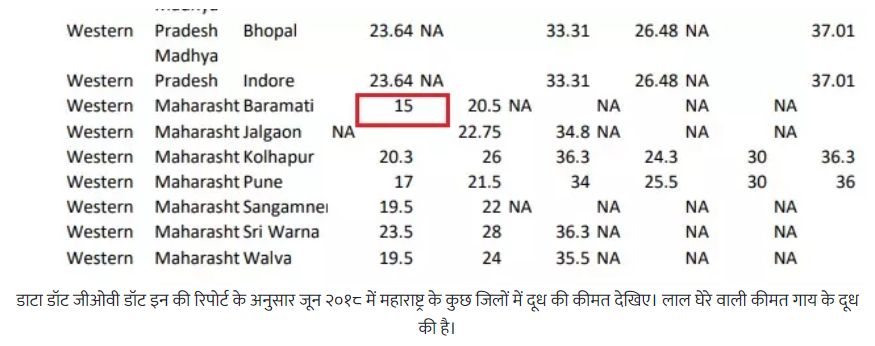
Sudhir Mohan, a farmer from Haidergarh district of Barabanki, about 40 kms away from Uttar Pradesh capital Lucknow, says that the cost of production (cost) is increasing. Giving examples, he explained: “One litre of cow’s milk costs at least Rs 35. My dairy produces 700 litres of milk daily. Milk companies and society are paying Rs 20-22 per litre for cow’s milk. Dairy farms cannot thrive upon such a low price. Earlier, I used to deliver my milk directly to the city which is still locked down. It is better to sell the milk at whichever price one is getting for it. Now, I have also started making ghee.”
When asked why cattle feed is getting costlier, YK Gupta, who runs a cattlefeed company in Kanpur rural, Uttar Pradesh, explained: “Before the lockdown, I used to manufacture 40 to 50 tonnes of cattle feed per day which went to nearby districts. Due to the lockdown, one the labourers aren’t available and second is that the transportation isn’t working. I am currently producing only 10-15 tonnes that too in the hope that there would be a demand when the lockdown ends. The cost of my raw materials has also gone up.”
Even before the lockdown, the dairy farmers of the country were not getting a very good price. The central government website had previously published a report of the Ministry of Agriculture and Farmers Welfare in the year 2018. The report had furnished state-wise milk prices. It covers certain districts across 13 states of the country. The price of milk in India is fixed on the basis of fat, so buffalo milk is better priced.
Cow’s milk with three per cent fat and 8.5 per cent natural material solids non-fat (SNF) never fetched more than Rs 31 per litre to farmers from any cooperative society. Rs 31 per litre cow’s milk was procured in Ernakulam district of Kerala. In many districts of Maharashtra, cows’ milk was procured at as low as Rs 15 per litre. While the state government had said that they would not buy cow’s milk for less than Rs 27 per litre, it simply did not happen.
According to the National Dairy Development Board report of June 2018, across cooperative sector in the country Maharashtra farmers get the the lowest rate. There have been farmers’ agitations in the past years against low milk prices in the state.
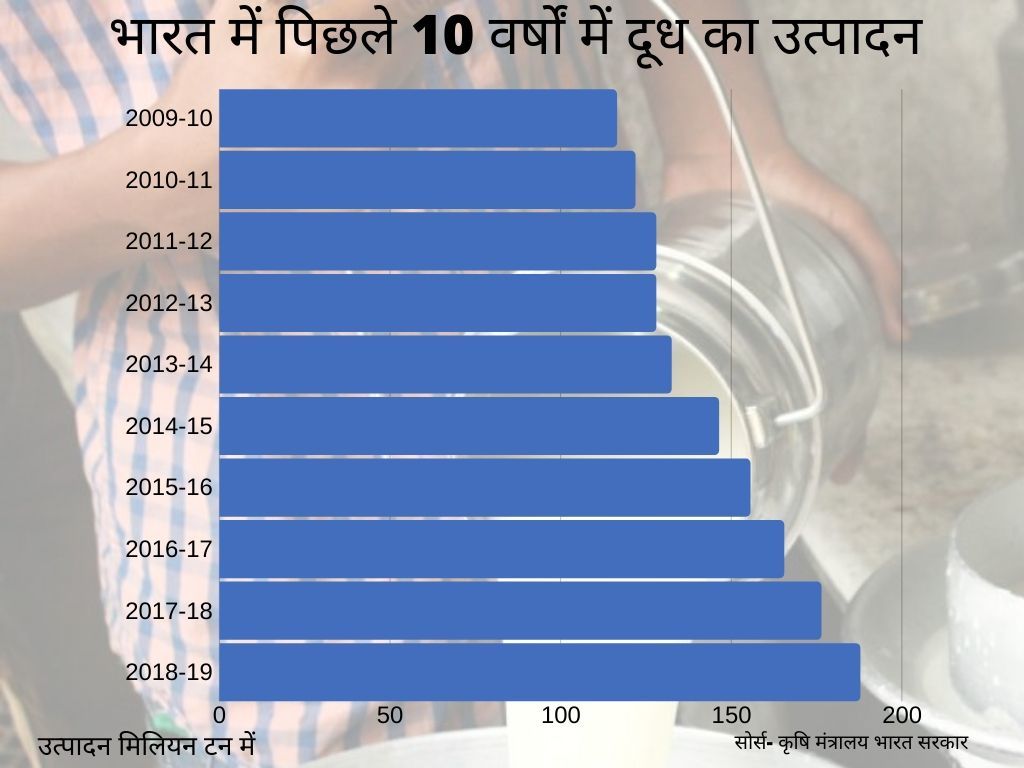
India is the largest milk producing country in the world. In 2018, 176.3 million tonnes of milk was produced in the country. There have been reports that the dairy sector of the country is in grave distress. People are bidding adieu to this sector. However, the central government issued a statement on July 9, 2019 claiming it to be untrue.
On behalf of the Ministry of Animal Husbandry and Dairying, the release said: “The Cooperative Milk Union (including 6% fat and 9% SNF) is selling milk from Rs 48 to Rs 56 per litre. In lieu of this, the farmers are being given Rs 29 to 39 per litre. Most of the milk companies are giving 60 to 80 per cent of the earnings from consumers to the producer, which is the highest in the world. In addition, annual bonus is also given.”
It stated further: “The number of farmers associated with dairy cooperatives is also increasing. There were 15.84 lakh dairy farmers in 2015-16, and which have increased to 16.57 lakh in 2017-18. Milk prices do not control the government. It is absolutely wrong that the farmers are leaving the dairy work and shifting focus elswhere.”
A report quoting the government also says that the Indian dairy sector has been growing at 6.4 per cent for the last four years. But still the fact remains that this sector is becoming a loss-making deal for the farmers involved in dairying. Private companies are making profits, but it is still beyond the reach of farmers.
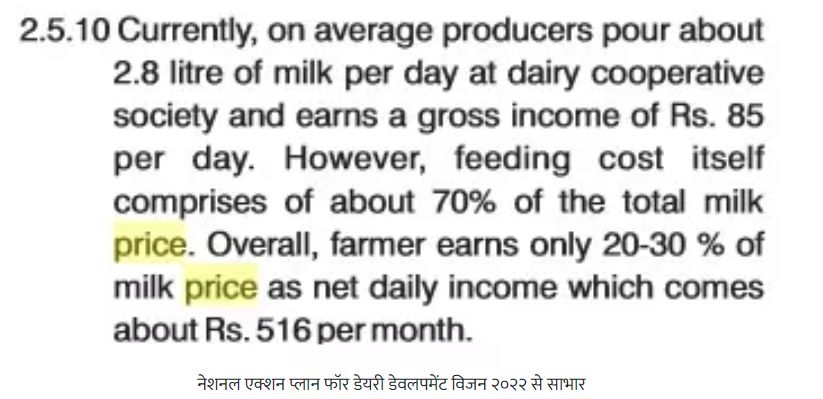
About five lakh milk producing farmers of the country are associated with Mohan Singh Ahluwalia, chairman of Kisan and Gair Milawati Samaj Gwala Gaddi Samiti residing in Panchkula, Haryana. He insists that milk companies are still managing profits. He said: “Even when farmers are suffering in this round of lockdown, government companies are not helping out the farmers. Rumours are spread that unpacked milk is causing corona. It is also harming the farmers.”
The farmers who sell milk in villages or run private dairies are the worst hit. The price has gone down by 40 per cent while government dairies have reduced the price by 20 per cent. The government will have to do something very quickly. How long will the farmer make ghee and in absence of any provision how will he sell it? The government should make milk procurement points every 10 kms so that the farmers get a fair price.
The rumours of unpackaged milk is also taken up by Amarnath Srinivasan residing in Vijayawada in Krishna district of Andhra Pradesh. He doesn’t face fodder problems because he has his own shop, but rumours have caused him a lot of damage.
He said: “People had spread rumours that open milk would cause corona. For several days, about 100 litres of my milk went wasted. I could hardly sell 150 litres of milk, even at half the price. The buffalo milk, which sells up to Rs 75/-litre, went down to Rs 50-55. The cost of packaging increased additionally. Even packaging material is not easily found. On the day it is not available, the milk sells at a very low price or not sells at all.”
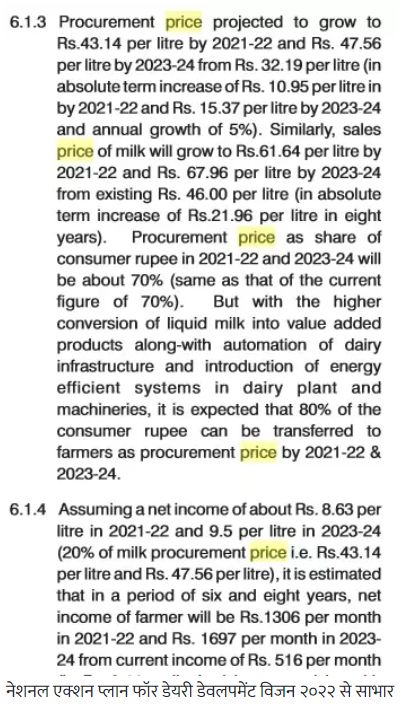
In 2018, the Ministry of Animal Husbandry and Dairying had written in the National Action Plan for Dairy Development Vision 2022 for the dairy sector that the average of milk production in India is only three litres per animal. Dairy farmers earn a total of Rs 85 a day. Out of this, 70 per cent is spent in feed (fodder). Monthly saving of farmers from the current price of milk is only Rs 516 (Rs 6.44 per litre).
The same report also says that the dairy sector can play an important role in doubling farmers’ income. By 2022, it had hoped to save farmers at least Rs 8.63 per litre of milk (20 per cent of the milk purchase price of Rs 43.14 per litre). It had also been targeted that withnin 2011-22, the income of dairy farmers will be increased from Rs 516 per month to Rs 1,306 (Rs 8.63 per litre), but now it does not seem possible.
In Jammu and Kashmir, the dairy farmer Ali Rashid, who is residing in Hazan village of Bandipora district, has eight cows. Earlier, he had sold milk in nearby dairy at the rate of Rs 30 to 35 per litre, but now he is unable to sell his entire yield despite half price.
He told Gaon Connection over the phone: “I used to sell 30-32 litres of milk. Two to three days since the lockdown, the nearby dairy was closed. They told how he would buy if he was not able to sell milk himself. Now, I am making ghee with some milk and sell some to a few villages, however, it is not easy to travel to the villages here. I had daily income from thedairy whereas now am facing difficulties. I go to villages selling milk at Rs 17-18 a litre.”
There is a large private company buying milk in the Jam-Jam valley, which used to buy 23,000 litres of milk daily before the lockdown. Terming Ali Rashid as correct, the company’s manager, Tajmul Islam, said: “It is true that the dairy farmers are not able to bring milk to us. We ourselves used to receive about 23,000 litres of milk a day which has now come down to 10,000 litres. This milk is coming too when our vehicles are somehow reaching the farms.”
Krishna Appa used to supply milk in Kanyakumari about 70 kms away from his village of Vellorkonam, block Neduangad in the district of Thiruvananthapuram, Kerala, every day before the lockdown. There he bargained and sold milk at a good price, but is now dismayed at the price he is getting currently. He told Gaon Connection over the phone: “I used to sell 80 to 90 litres of milk per day for Rs 38 to 40 a litre. Unable now to go because of the lockdown, the same milk is to be sold in the villages at Rs 21-22 per litre. At times, if the milk is not sold, we make ghee or consume it ourselves or give some in the neighbourhood.”

Ashok Kumar of Sanver Tehsil, Madhya Pradesh, Indore, said: “The milk business was not a profitable business as it is. Previously too, our milk was sold at Rs 20-21, now it has come down further to Rs 17-18 per litre. We supply cow’s milk which is also low in fat. Earlier, the expenditure on a cow was between Rs 200 to 225, now the same expenditure has gone up to Rs 400. The price of the feed has gone up. We don’t know any profit but the deficit is, for sure, increasing.”
Pushpendra Singh Chaudhary, the president of the Kisan Shakti Sangh said: “Dairy farmers are very important for the economy of the country so the government should soon find some way out for them. While the price of milk has gone down by 30 per cent, the cost has also gone up in same proportion. It is causing a lot of damage to the farmers who sell milk every day and run their households. We have 70 per cent very small and small farmers who used to earn a little bit of profit by selling milk. Their work has been completely stopped.”
India has an agricultural production worth about Rs 28 lakh crore. Its 25% share — about Rs 7 lakh crore comes from milk. If we consider the total income from animal husbandry, including milk, its participation is of about 30% in agriculture. Price-wise milk is the largest yield in the country.
The price of milk produced in the country is more than the combined price of both wheat and rice crops. Milk is produced seven times the price of sugarcane crop in the country. With about 180 million tonnes of milk production, we produce 20% of the world’s milk and have remained in the first place for the last two decades.
According to a report by the NITI Aayog, in 2016-17, we had produced 1.5 million tonnes of milk — 16.3 million tonnes more than our domestic demand of 14.8 million tonnes. In 2032-33 also, the country is estimated to have 33 million tonnes of milk production against a demand of 29 million tonnes. That is, our country is not only self-reliant in milk in terms of present and future but also in a position to export milk products to markets in other countries.
“With the price rise of fodder, the farmers are giving less food to the cattle. The effect will not be visible yet. When the cow-buffaloes do not get the right food, their calves will also be weakened, the fat from milk will be low. The next breed will be weakened and it cannot be deemed favorable for India’s dairy sector,” said Pushpendra Singh.
When asked what can be done to minimize farmers’ loss, he said: “There is no dearth of milk production, nor is there any problem of demand, the difficulty is in its supply to the people. The government should also supply milk as they are supplying ration. Give milk or milk products to the poor who are short of food, or those who have been quarantined. For this, Aadhaar can be used as a ration card. It will benefit the poor as well as the farmers.”
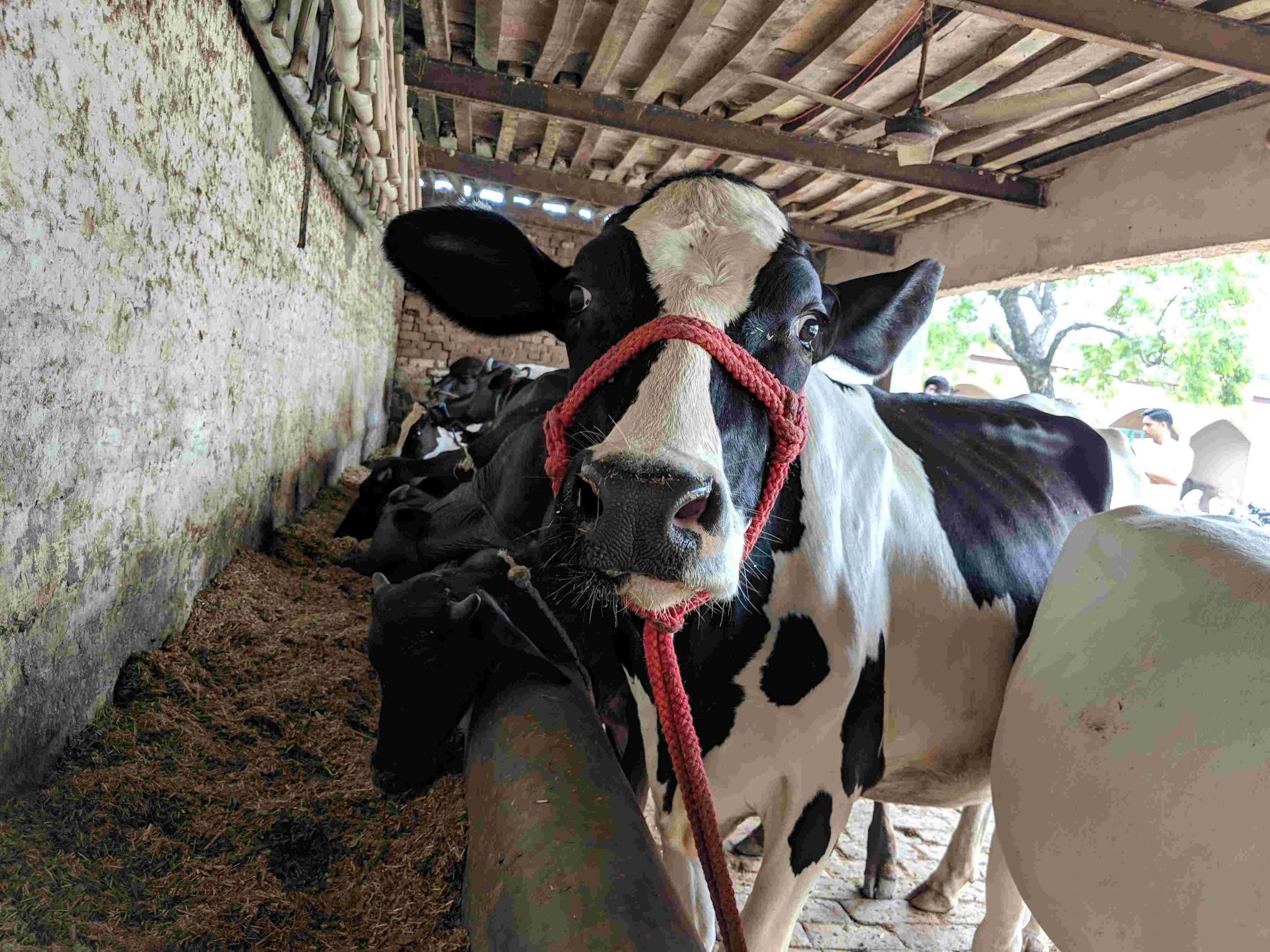
The farmer leader, Bhagwan Meena of Madhya Pradesh is demanding financial assistance from the government for the farmers. He said: “It is a season of weddings, there would have been a lot of demand for milk, but the farmers are suffering a huge loss because of the lockdown. Many people are suggesting the farmers that they make ghee, but the farmers will be harmed here too due to spurious ghee in the markets. Now, the government should announce an economic package for the dairy farmers.”
Varun Jakkinapalli, 32, from Ranggareddy district, Telangana, is counted among the large milk producing farmers in the area. He has 300 cows and produces about 2,500 litres of milk every day. He told Gaon Connection over the phone: “We used to supply most of the milk directly to the houses because we were getting a price of Rs 30 per litre from the company, whereas we sold milk up to Rs 42 a litre. The same milk is now selling for Rs 20-25 a litre in the local market. Milk is a perishable item which we cannot even keep for many days. Earlier, I used to sell only 1,000 litres of milk per day to the company whereas now the complete output is sent there. It means a daily loss of up to Rs 40,000.”
RS Sodhi, managing director, Gujarat Cooperative Milk Marketing Federation Limited (AMUL), the country’s largest milk and milk products cooperative institution, told Gaon Connection: “Private companies are buying more milk than ever before to help the farmers. We had a meeting recently in which everybody said that they are trying to buy more and more milk. AMUL has increased its milk procurement from other states by 80 per cent. The closure of hotels, sweets shops, etc, has reduced the consumption of milk, which has been a loss to the farmers who are not able to sell milk to the cooperative.”
Where cooperatives are in good condition, the farmers are not in trouble, as you take the example of Gujarat and Rajasthan. Gradually, the heat is increasing and so the milk production is also decreasing and the cost of farmers has also increased due to shortage of fodder, so they feel that they are suffering more. The government and the milk companies are working together on this. Everything will be back on track in the coming few days.”

